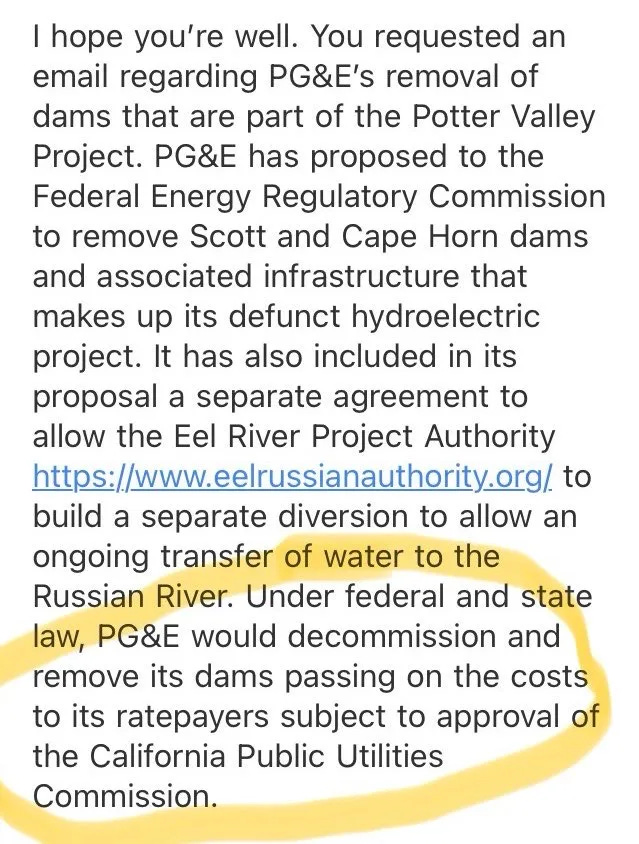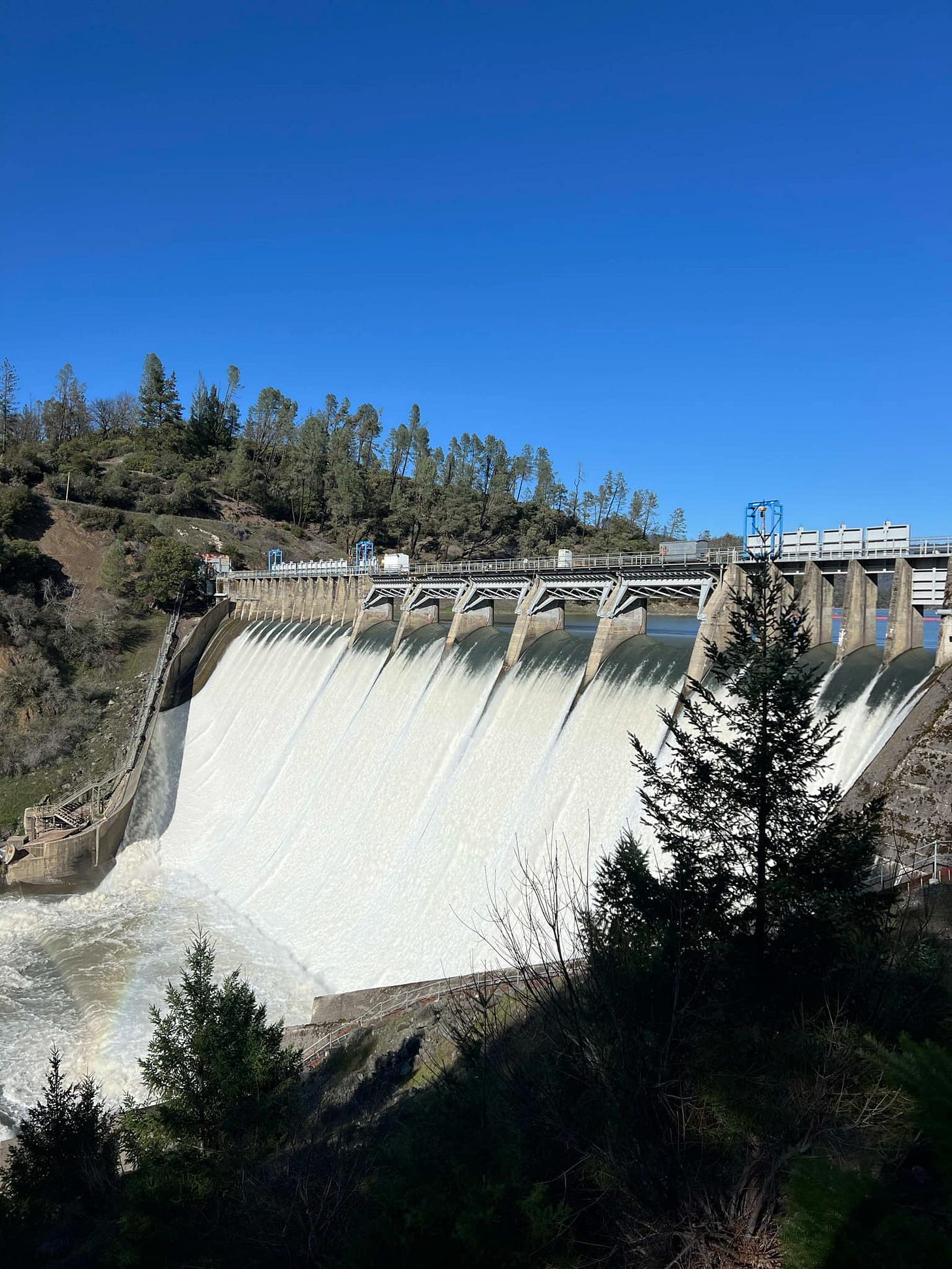PRIVATE BUSINESS DECISION? The truth about NGO lawsuits and government water cuts behind Potter Valley dam removals
The real story of backroom deals, bureaucratic red tape, and NGO muscle set to disenfranchise 600,000 water users in California's North Coast.
Contrary to media framing, Pacific Gas & Electric (PG&E) did not make its decision to surrender and remove the Potter Valley dams in a vacuum.
While the decision has been framed as a business decision to relinquish an expensive, aging hydropower project relied on by a low-income, rural, and therefore expendable community, there’s more to the story.
From backroom deals and lawsuits to federal regulatory burdens and interference from outside environmental groups, the decision to disenfranchise 600,000 water users appears to have been influenced by significant outside pressure. Local leaders say the impact will be severe.
“Our economy will fail, our housing prices will plummet, our health and hygiene will be at risk, our ability to prevent and stop fires will be at risk,” says Todd Lands, mayor of Cloverdale in Sonoma County. “We have to make sure we have the basic necessities of life. This is not a partisan ask, this is a community need.”
Throughout the process, the preferences of environmental non-profits and non-governmental organizations (NGOs) appear to have held outsized power in the future of the dams—to the exclusion of local elected representatives.
PG&E is a state-regulated utility company
In 2019, PG&E announced they would not pursue license renewal for the Potter Valley project, a 100 year-old dam system. Now the company is pursuing removal and destruction of these dams—a decision that will cut water to hundreds of farms and ranches.
PG&E is a state-regulated utility company serving Northern and Central California. The California Public Utilities Commission (CPUC) regulates rate increases. Last year, despite record profits, CPUC greenlit six rate hikes. The CPUC board is appointed by the governor. There’s a history of political influence at PG&E, including regular donations to almost ever politician in the state.
This background is not insignificant to Representative Jared Huffman’s office confirming earlier this year that ratepayers will foot the bill for dam removal in an email seen by UNWON.

While the dam removal is being framed as a financial decision by a private company, the fact that PG&E is a state-regulated monopoly with a history of political influence, and that taxpayers will be forced to pay to destroy their own water source in a decision approved by the state, complicates that narrative.
Beginning of the end: Federal report on fish impact led to 50% water cuts
In 2004, the government ordered PG&E to make dramatic cuts to the Potter Valley Project following a 2002 review from the National Marine Fisheries Service (NMFS). This report, called a Biological Opinion (or BioOp), found that continued operations of the Potter Valley Project were likely to jeopardize endangered Chinook salmon and steelhead.
In the BioOp, NMFS emphasized that the dams were not the only factor in declining fish populations, listing other causes such as logging, historical commercial fishing, and floods in 1955 and 1964.
PG&E was ordered to cut diversions for hydropower production at the Potter Valley Project by over half, from 150,000 acre feet to 60,000 acre feet. The water cuts made the hydropower project unprofitable and led to PG&E’s decision in 2019 not to pursue relicensing. PG&E is now in the process of submitting a final license surrender to the Federal Energy Regulatory Commission (FERC), due by July 2025.
Lake Pillsbury was also impacted by the BioOp.
“A condition in PG&E’s hydropower lease that guaranteed recreational water levels for Lake Pillsbury disappeared from the revised license, with a mere reference in a footnote,” says Carol Cinquini of the Lake Pillsbury Alliance, a local advocacy group. “Most likely because of the BiOp recommendations. That was the beginning of what has been an ongoing downward spiral for what was once a pristine lake.”
Lawsuits from environmental groups and NGOs pushed for dam removal
Not much data on fish populations is available after the BioOp went into effect, but what little there is shows negligible to no improvement. A 2010 review by California Department of Fish & Wildlife (CDFW) found that though juvenile Chinook survival rates improved—due at least in part to reduction in predator pineminnow fish due to reduced summer flows—adult salmon populations remained low. This report did not control for any other contributing factors such as ocean conditions or logging. According to NMFS’s 2014 assessment, habitat conditions improved below Cape Horn Dam, but Chinook salmon and steelhead numbers did not improve.
Instead of updating their priors in light of data showing that dramatic water cuts did not improve fish populations, environmental groups doubled down.
In 2022, a coalition of five green groups sued FERC saying the agency violated the Endangered Species Act (ESA) by operating the Potter Valley Project. The coalition included California Trout, Friends of the Eel River, Pacific Coast Federation of Fishermen’s Associations, the Institute for Fisheries Resources, and Trout Unlimited.
At the time, PG&E defended the project and its impact on fish populations.
“There are a multitude of adverse influences along the approximately 160 mile-long Eel River corridor that affect salmonids and PG&E believes its operations benefit salmonids by storing and providing water that otherwise would not be available for release, particularly during dry seasons,” Paul Moreno, marketing and communications principal for PG&E, told The Mendocino Voice.
Then in 2023, environmental non-profits filed yet another lawsuit over the dams—this time against PG&E. These groups pushed for dam removal, not just decommissioning, claiming the dams blocked fish passage.
NGO blocked Lake County from seat at the table for dam ownership
“We know where we stand,” says Eddie “E.J.” Crandell, chairman of the Lake County Board of Supervisors and vice chair of the Robinson Rancheria of Pomo Indians. “We’ve always stood in this position to advocate for Lake Pillsbury because it’s the main thing that’s kept us whole when it comes to fires.”
At one point, a group of stakeholders known as the Notice of Intent or NOI Parties, was formed to examine options for the future of the Potter Valley Project, including taking over management of the dams from PG&E. Members included Mendocino County Inland Water & Power Commission, Sonoma County Water Agency, the county of Humboldt, Round Valley Indian Tribes, and Cal Trout.
Crandell says Lake County explored options to join the NOI Parties. They were told to bring $100,000 as an entry fee.
“We ended up getting that,” Crandell says. “We met with each and every agency and we had really good meetings with Round Valley, Mendocino Inland Water, Sonoma. They were all actually in favor of us joining. There was just one group that did not.”
The group that did not want Lake County to join talks? Cal Trout.
“They said no, but the others said yes, and we weren’t allowed to be at the table.”
In a letter to FERC, then-Congressman John Garamendi wrote,
Apparently, the ‘notice of intent’ parties’ standing rules require approval of all current members before another party may join. CalTrout – a nongovernmental organization that will likely have no official role in the future governance of the Potter Valley Project under the to-be established regional entity – voted to block Lake County from joining its peer county governments (Mendocino, Sonoma, and Humboldt) as a ‘notice of intent’ party. This is not acceptable.
Scott Dam and Lake Pillsbury are located in Lake County.
Another narrative has been that no one in the community stepped up to take over the dam when it was an option. Crandell takes issue with this depiction.
“How are we going to really take it over as a county? We don’t have the resources, you know, we would want to partner with people to do so. And that’s what we thought the NOI would have been.”
Sonoma report finds keeping dams best scenario; abandons option after discussions with NGOs
As previously reported, Sonoma County Water released a detailed report examining options for the future of the Potter Valley Project. Across metrics, keeping the dams was the best option for the community—from water reliability to cost. This option was axed, however, because it failed in one area: Meeting the unspecified “objectives” of NGOs and government groups.

“Only one solution provided water security for both the environment and humans, but that solution was not allowed to be explored further,” says Lands. “The alternative I am speaking about is the most cost-effective, reliable, and easiest to construct. So when they talk about money, know that they are discounting the one that is easiest, fastest, and cheapest to do, that helps everyone. The only negative about this is the groups that I just mentioned. That’s the only negative.”

Is this a private company’s decision? Or a radical agenda forced down by NGOs and federal agencies?
The narrative around the Potter Valley dam removals has excluded local voices and agency by framing the decision as a utility company’s detached business decision.
Most media outlets and politicians have refused to acknowledge the impact of regulatory burdens, environmental groups, NGOs, and other outside interests pushing toward a decision that profoundly impacts the fate of 600,000 rural residents while excluding many of those residents from a seat at the table. It seems the only part of the process impacted users will be involved in is paying for the destruction of their own water and communities.
North Coast residents will be left without water, without a voice, and with a bill PG&E will not have to pay.





Your last line says it all. It's so heartbreaking. Who is CalTrout... really? I smell a rat.
Thanks for getting this out there! Are you coming to the Lake County "Town Hall Meeting" sponsored by the Lake Pillsbury Alliance. May 28th. 5:30-7:30 @ the Soper Reese Theatre
in Lakeport? Cheers!